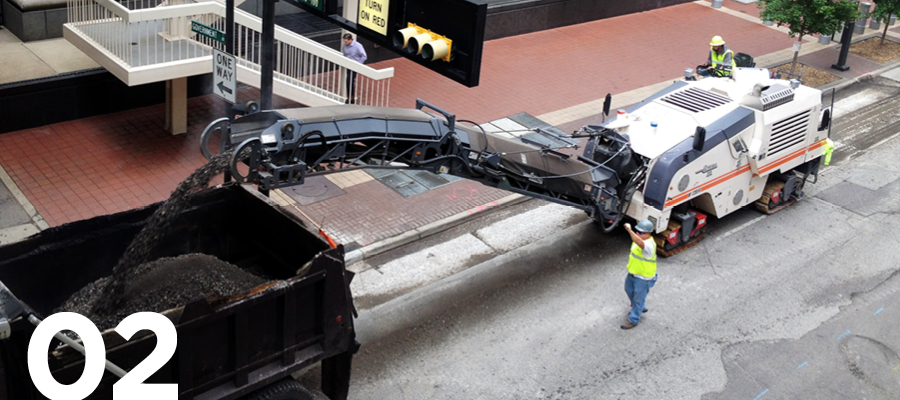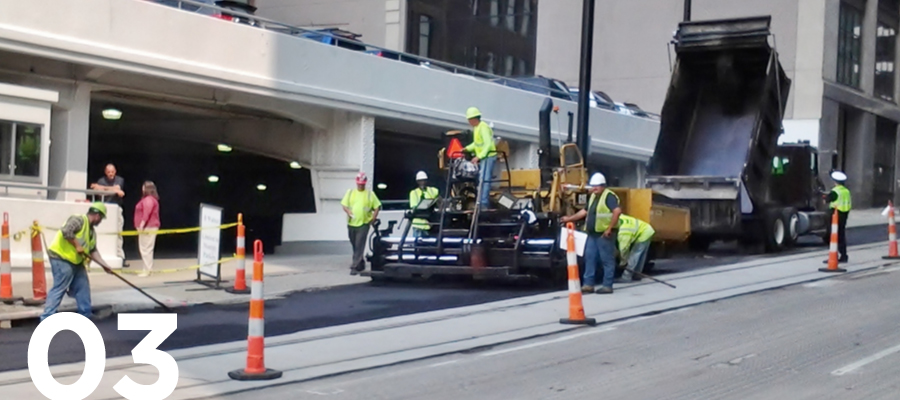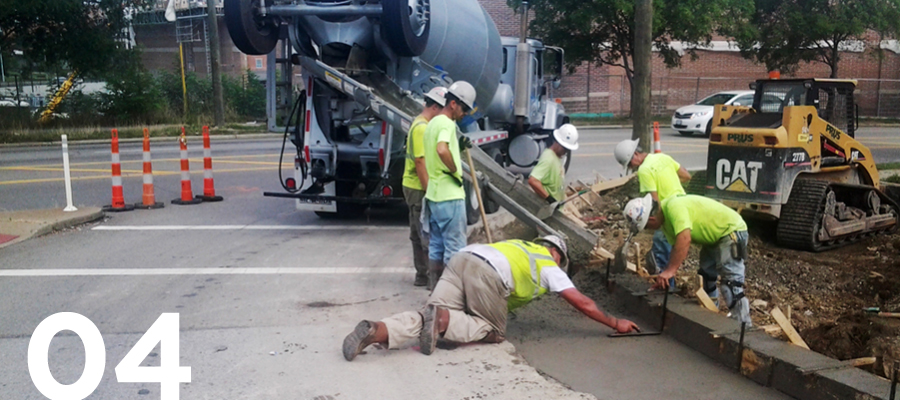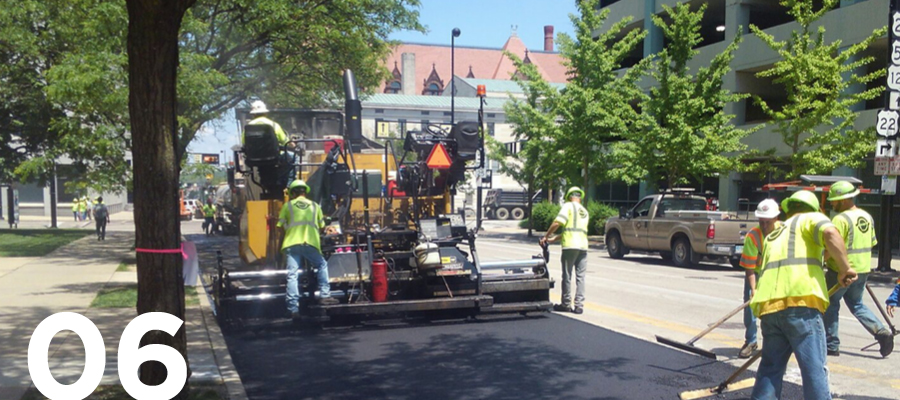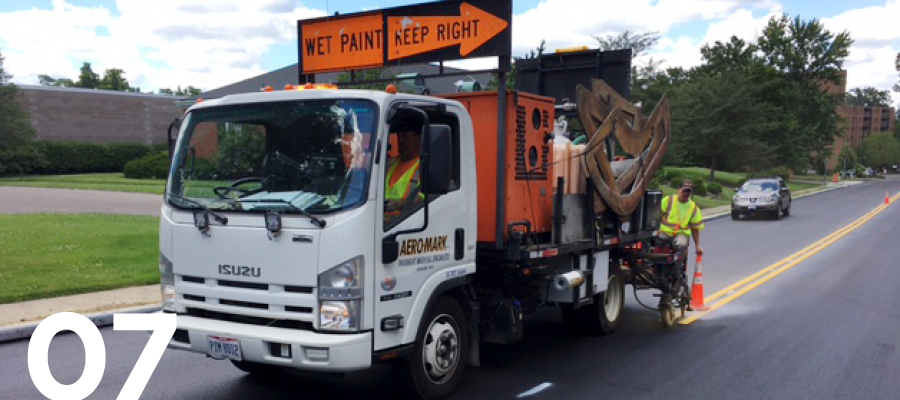Street Rehabilitation Program
The Department of Transportation & Engineering (DOTE) manages 2,935 lane miles of streets in the City of Cincinnati, covering all 52 neighborhoods. DOTE's focus is its annual street rehabilitation program, which is budgeted at approximately $25 million annually. DOTE gets additional funding from grants.
The above photos show the seven major steps associated with traditional street rehab.
Did you know?
- A street rehab project typically includes asphalt and curb repairs, preventive maintenance, resurfacing and new pavement.
- A lane mile is a common area of measurement in street rehab. It factors in the total amount of pavement and aggregate base needed to cover an area 10-feet wide by 1 mile long.
- The work isn't always continuous from start to finish. There may be breaks for an extended period while the contractor performs work on other roads. This is part of the scheduling process to minimize costs. Streets are complete once pavement is fully replaced and a smooth driving surface is restored.
- Every neighborhood in the city is targeted for roadwork on a three-year rotation.
View the Most Current Street Rehab LisT
We rehabilitate approximately 50 to 100 lane miles per year out of the estimated 2,935 lane miles in the city's roadway network.
Every neighborhood in the city is targeted for roadwork on a three-year rotation. A few select streets in each targeted neighborhood are rehabbed each year starting with those in the worst condition. The following color-coded map shows the three-year rotation or cycle by neighborhood.
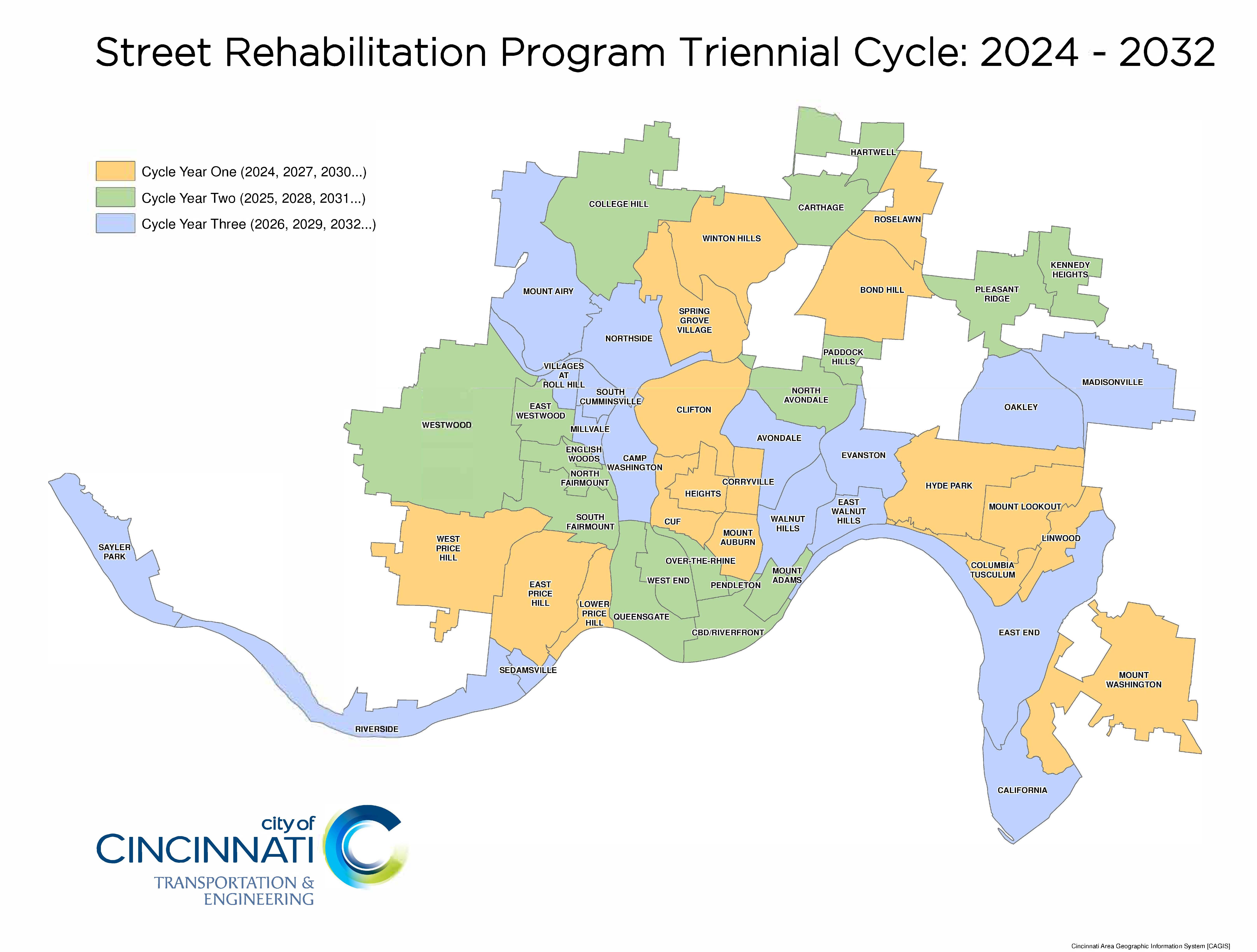
Printable Version of Above Map
The following chart shows the city's Pavement Condition Index (PCI), a scale we use to quantitatively measure the status of every street's condition. We assign each of the city's 6,000 + streets a numerical rating from zero to 100.
We assess the status of each of the city's 6,000 + streets every year by scoring their respective condition on a scale of zero to 100. We call this scale our Pavement Condition Index, or PCI. The city's overall PCI rating is 67 based on latest data available.
Streets are graded by block or segment and corresponding intersections. We average those grades to produce a single numerical value per street and call it the "PCI" score.
PCI scores are grouped/rated as follows:
- 92 to 100 ► Excellent
- 82 to 91 ► Very Good
- 68 to 81 ► Good
- 50 to 67 ► Fair
- 35 to 49 ► Poor
- 20 to 34 ► Very poor
- 0 to 19 ► Failed
Following is our most current pavement management report. Please check back in early spring for our 2023 report.
| FY 2018 | FY 2019 | FY 2020 | FY 2021 | FY 2022 | FY 2023 | FY 2024 | FY 2025 | |
|---|---|---|---|---|---|---|---|---|
| Street Rehab CIP Budget | $15.4 m | $15.3 m | $13.4 m | $13.5 m | $16.2 m | $17.1 m | $18.5 m (est.) | $12.9 m (est.) |
| Street Rehab CAP Budget | $11.4 m | $9.1 m | $10.0 m | $2.0 m | N/A | N/A | N/A | N/A |
| Rehab Cost Per LM | $274,000 | $321,000 | $330,000 | $330,000 | $330,000 | $500,000 | $520,000 (est.) | |
| Total LM Rehab, excluding grants | 96 | 36 | 62 | 42 | 29 | 30 | 20 (est.) | 24 (est.) |
| Preventive Maintenance Cost Per LM | $35, 500 | $45,600 | $45,600 | $48,000 | $48,000 | $70,466 | $70,466 (est.) | |
| Total LM Preventive Maintenance | 98.5 | 44.3 | 50.4 | N/A | 34 | 24.3 | 23 (est.) | 19 (est.) |
Notes:
- FY 2024 and 2025 data is estimated
- FY 2025 data not yet available
- Dollar amounts are rounded to nearest hundred thousand place
- LM = Lane mile
- CIP = Capital Improvement Program funded by DOTE budget
- CAP = Capital Acceleration Plan, which was in place during fiscal years 2016 to 2021.
- No preventive maintenance was conducted in fiscal year 2021 due to the COVID 19 pandemic.
- Lane miles reported as completed in a given construction season may be funded by multiple prior budget fiscal years.
- A lane mile is a common measurement used in street rehab. It factors in the total amount of pavement and aggregate base needed to cover an area 10-feet wide by 1 mile long.
Q: How do I know when my street is scheduled for work?
A: You will receive a door hanger prior to work being performed, typically two weeks prior. “No Parking” signs marked with the scheduled day and date of work will be posted along the street.
Q: What time will work be performed?
A: Normal work hours are 7:00 a.m. to 6:00 p.m. You may see crew members as early as 6:30 a.m. on the first street doing prep work.
Q: If I live on a private street, how does it get rehabilitated?
A: Private streets, even those within city limits, aren't maintained by the City of Cincinnati. Private streets are typically maintained by the property owners on the street.
Q: Can I park on the street while it's being rehabbed?
A: No. If your vehicle is left on the street, per city code, it will be towed to allow the work to be performed. Please leave your vehicle in your driveway or parked on an adjacent street not scheduled for work.
Q: Where do I park if I need to leave during the scheduled hours?
A: It's best to leave your vehicle on a nearby street if you think you may need to leave. If there is an emergency, ask for the city inspector or contractor foreman on site for help.
Q: What do I do if my trash is scheduled for pick-up the same day as road maintenance?
A: Put your trash out the night before. The contractor will coordinate with waste removal for early pick up.
Q: What if I have service scheduled or deliveries at my house?
A: Please delay or coordinate with any companies (deliveries, lawn care, home improvement, etc.) you have scheduled. With the traffic and parking restrictions, it will be difficult for them to maneuver their vehicles and find adequate parking.
Q: Will school buses be able to access pick up locations?
A: There should be no disruption to morning pick ups. The contractor will coordinate if afternoon locations need to be adjusted.
Q: What is there is an emergency in my area?
A: Police, ambulance and fire personnel will be able to access the streets and home of any resident in the event of an emergency.
Q: What happens if it rains?
A: The contractor will reschedule and "No Parking" signs will be updated to show the day work will resume.
Q: Should I turn my sprinklers off that day?
A: If possible, yes.
Q: My street in scheduled to be completed but nothing has yet been done today, why?
A: A contractor typically schedules several nearby streets to be completed each day. Some will be finished early in the day and others later in the afternoon.
Q: What should I do if I have other questions or an unusual circumstance and cannot find a city inspector or foreman to talk to about it?
A: Call the City of Cincinnati's Street Rehab team at 513-352-3465.


